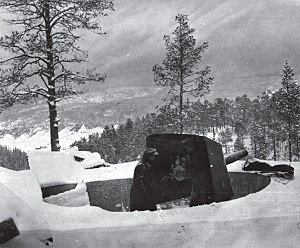Battle of Hegra Fortress
| Battle of Hegra Fortress | |||||||
|---|---|---|---|---|---|---|---|
| Part of the Norwegian Campaign | |||||||
 Norwegian 7.5 cm gun position |
|||||||
|
|||||||
| Belligerents | |||||||
|
|
|
||||||
| Commanders and leaders | |||||||
| Hans Reidar Holtermann (POW) |
15–20 April: Weiss 20 April-5 May: Kurt Woytasch |
||||||
| Strength | |||||||
|
Positional artillery: 4×10.5 cm guns and 2×7.5 cm guns under Captain Evjen with 25 men Field artillery: 4×8.4 cm guns under 2nd Lieutenant Reitan with 10 men Total force: 250 volunteer soldiers and one female volunteer nurse, most of whom had had a short national service with Artillery Regiment no. 3 (AR 3) before the war |
15–27 April: 138. Gebirgsjägerregiment 27 April-5 May: 181. Infantry Division Troops involved: Force levels were on average ca. one battalion and one reinforced company of infantry, as well as an artillery unit with numerous mortars, cannon and howitzers |
||||||
| Casualties and losses | |||||||
| 6 killed 14 wounded 200+ taken prisoner |
150-200 killed or wounded 1 taken prisoner 1 Luftwaffe aircraft destroyed and 1 damaged |
||||||
|
Civilian casualties: One Norwegian civilian killed and two Finnish civilian refugees wounded |
|||||||
The Battle of Hegra Fortress was a twenty-five-day engagement in the 1940 Norwegian Campaign which saw a small force of Norwegian volunteers fighting superior German forces. After initial fighting around the Meråker Line railway line, the Norwegians pulled back into Hegra Fortress and held off further German attacks before surrendering on 5 May as one of the last Norwegian units active in southern Norway.
The Norwegian defenders were 250 volunteer soldiers and the volunteer nurse Anne Margrethe Bang. Most of the volunteers that served at Hegra were from the area Hegra/Stjørdal/Trondheim, but they also included three Swedes.
The garrison at Hegra was equipped with small arms (Krag-Jørgensen rifles and carbines), as well as Madsen and Colt M/29 machine guns.
The fortress also had artillery, four 10.5 cm (4.13 in) and two 7.5 cm (2.95 in) positional pieces of reasonably modern make in half-turrets; as well as four Krupp m/1887 8.4 cm (3.31 in) field guns. The artillery had a maximum range of between six and nine kilometres.
Many of these men had been mobilized to Artillery Regiment no. 3 at Øyanmoen army camp at Værnes Air Station and were brought to Hegra to continue the mobilization after the Germans had reached their camp. The fortress at Hegra was originally only intended as a temporary refuge for the artillery regiment, but ended up as the centre of the volunteers' war in 1940.
The attacking force initially consisted of Gebirgsjäger of the German 138. Gebirgsjägerregiment (part of the 3. Gebirgsdivision), which landed in Trondheim on 9 April. Later, from 20 April to 27 April, the Germans substituted the 138. Gebirgsjägerregiment with units from the 181. Infantry Division and the 138. Gebirgsjäger were sent north to try to relieve their comrades at the Narvik Front.
...
Wikipedia
